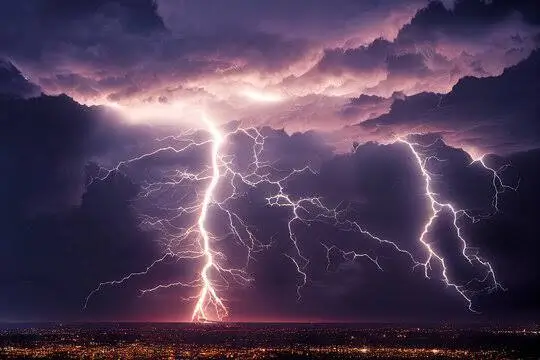What is Lightning?
Lightning is a giant spark of electricity in the atmosphere between clouds, the air, or the ground. In the early stages of development, air acts as an insulator between the positive and negative charges in the cloud and between the cloud and the ground. When the opposite charges build up enough, this insulating capacity of the air breaks down and there is a rapid discharge of electricity that we know as lightning. The flash of lightning temporarily equalizes the charged regions in the atmosphere until the opposite charges build up again.
Lightning can occur between opposite charges within the thunderstorm cloud (intra-cloud lightning) or between opposite charges in the cloud and on the ground (cloud-to-ground lightning).
Lightning is one of the oldest observed natural phenomena on earth. It can be seen in volcanic eruptions, extremely intense forest fires, surface nuclear detonations, heavy snowstorms, in large hurricanes, and obviously, thunderstorms.
Most, if not all, lightning flashes produced by storms start inside the cloud. If a lightning flash is going to strike ground, a channel develops downward toward the surface. When it gets less than roughly a hundred yards of the ground, objects like trees and bushes and buildings start sending up sparks to meet it. When one of the sparks connects the downward developing channel, a huge electric current surges rapidly down the channel to the object that produced the spark. Tall objects such as trees and skyscrapers are more likely than the surrounding ground to produce one of the connecting sparks and so are more likely to be struck by lightning. Mountains also make good targets. However, this does not always mean tall objects will be struck. Lightning can strike the ground in an open field even if the tree line is close by.
आकाशीय बिजली क्या है?
बिजली बादलों, हवा या जमीन के बीच वातावरण में बिजली की एक विशाल चिंगारी है। विकास के शुरुआती चरणों में, हवा बादल में सकारात्मक और नकारात्मक चार्ज और बादल और जमीन के बीच एक इन्सुलेटर के रूप में कार्य करती है। जब विपरीत आवेश पर्याप्त मात्रा में बढ़ जाते हैं, तो हवा की यह इन्सुलेशन क्षमता टूट जाती है और बिजली का तेजी से निर्वहन होता है जिसे हम बिजली के रूप में जानते हैं। बिजली की चमक अस्थायी रूप से वायुमंडल में आवेशित क्षेत्रों को तब तक बराबर कर देती है जब तक कि विपरीत आवेश फिर से न बन जाए।
बिजली गरजने वाले बादल (इंट्रा-क्लाउड लाइटनिंग) के भीतर विपरीत चार्ज के बीच या बादल और जमीन पर विपरीत चार्ज (क्लाउड-टू-ग्राउंड लाइटनिंग) के बीच हो सकती है।
आकाशीय बिजली पृथ्वी पर देखी गई सबसे पुरानी प्राकृतिक घटनाओं में से एक है। इसे ज्वालामुखी विस्फोटों, अत्यधिक तीव्र जंगल की आग, सतह पर परमाणु विस्फोटों, भारी बर्फीले तूफानों, बड़े तूफानों और जाहिर तौर पर गरज के साथ देखा जा सकता है।
अधिकांश, यदि सभी नहीं, तो तूफानों से उत्पन्न बिजली की चमक बादल के अंदर शुरू होती है। यदि बिजली की चमक जमीन पर गिरने वाली है, तो सतह की ओर नीचे की ओर एक चैनल विकसित हो जाता है। जब यह ज़मीन से लगभग सौ गज से भी कम दूरी पर रह जाता है, तो पेड़, झाड़ियाँ और इमारतें जैसी वस्तुएँ इससे मिलने के लिए चिंगारी भेजना शुरू कर देती हैं। जब एक चिंगारी नीचे की ओर विकसित होने वाले चैनल से जुड़ती है, तो एक बड़ा विद्युत प्रवाह तेजी से चैनल के नीचे उस वस्तु की ओर बढ़ता है जिसने चिंगारी पैदा की थी। पेड़ और गगनचुंबी इमारतों जैसी ऊंची वस्तुओं में आसपास की जमीन की तुलना में कनेक्टिंग स्पार्क उत्पन्न होने की संभावना अधिक होती है और इसलिए बिजली गिरने की संभावना अधिक होती है। पहाड़ भी अच्छे लक्ष्य बनाते हैं। हालाँकि, इसका मतलब यह नहीं है कि ऊँची वस्तुएँ टकराएँगी। बिजली खुले मैदान में जमीन पर गिर सकती है, भले ही पेड़ की रेखा करीब हो।




